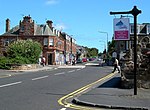Luffness Platform railway station
1898 establishments in Scotland1932 disestablishments in ScotlandDisused railway stations in East LothianFormer North British Railway stationsPages with no open date in Infobox station ... and 4 more
Railway stations in Great Britain closed in 1932Railway stations in Great Britain opened in 1898Scotland railway station stubsUse British English from June 2017
Luffness Platform (also known as Luffness Golf Club Halt) served a golf course near Gullane in Scotland. It was served by the Aberlady, Gullane and North Berwick railway. This line diverged from the North British Railway Main Line at Aberlady Junction, east of the current Longniddry station. For the private use of members of the Luffness Golf Club, this unstaffed halt was opened in 1898 and closed in 1932. Passengers alighting had to inform the train guard at Gullane or Aberlady and passengers joining the train there had to request it to stop by hand signals.
Excerpt from the Wikipedia article Luffness Platform railway station (License: CC BY-SA 3.0, Authors).Luffness Platform railway station
Saltcoats Road,
Geographical coordinates (GPS) Address External links Nearby Places Show on map
Geographical coordinates (GPS)
| Latitude | Longitude |
|---|---|
| N 56.0235 ° | E -2.83 ° |
Address
Luffness
Saltcoats Road
EH31 2AG
Scotland, United Kingdom
Open on Google Maps





